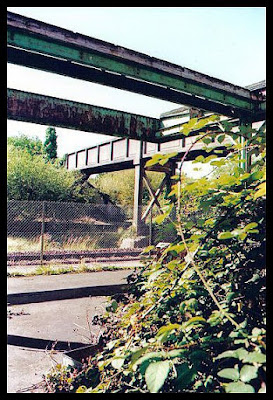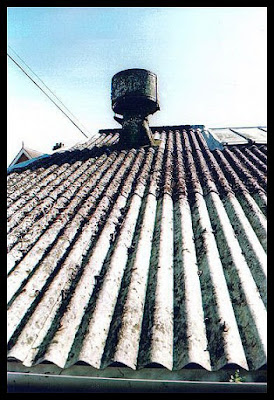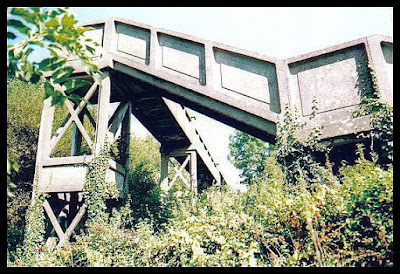Seaton Junction is not only the name of the abandoned station and defunct junction, but is also the name of the little community which lives around it, and belonging to the nearby Shute village. Apart
from the station building itself, there are two footbridges, the former goods yard, an overgrown and
abandoned platform on the opposite side of the rails, plus derelict
factory and office buildings next door to the station. A former hotel, The Shute Arms, is situated across the road from the station - and has since been converted into flats - although I didn't take any photos of it on my visits.
Originally called Colyton for Seaton, it was given the name Seaton Junction in 1869, a year after the opening of the Seaton Branch Line. As well as an important part of the holiday traffic for the seaside, the station accommodated Express Dairy Depot next door. A fleet of vans was used to collect milk, eggs and other dairy products from local farms, which were then loaded on to six-wheel tank wagons and sent by rail up to London.
The buildings included housing for the station master, who apparently was a keen gardener, growing vegetables as well as flower displays along the station platform. Part of the now overgrown garden can be seen below.
I haven't been able to discover much about the station building itself, as it doesn't appear to be listed. However, it was designed for the London & South Western Railway by the architect Sir William Tite and is a lovely Victorian Gothic building. Built with red brick, the limestone quoins and framing around the doors and windows is probably Beer Stone, from the quarry above the village of Beer. This would make sense as the stone was taken to Seaton station from the quarry and then transported on the branch line trains to Seaton Junction before being loaded onto trains for elsewhere.
It was great seeing the old telephone box. I didn't check whilst there but I wonder if it was still connected for use. And, I wonder if it's still there now that it's been almost eleven years since my last visit.
I came here twice; once in September 2008 in a visiting friend's car then again in September 2010 by myself, partly on bus plus a good walk. On the first visit I took the photos above through the window, when there appeared to be a free standing wall on the left hand side, possibly part of the booking office. And below, on the second visit, which shows the wall no longer there.
The
station platform footbridge is inaccessible, as is the platform and the
inside of the station itself, but the second footbridge can be crossed,
which is great for looking down on the one existing line which still
runs between Exeter and London and the abandoned station platform.
These photos were taken through a boarded off entrance onto the platform; the top two on my first visit, the others on my second. The right hand ones clearly show the platform bridge spanning what was once three tracks, now only the one for the Exeter to London trains.
The
Express Dairy depot next door was later used by Axminster Engineering &
Mouldings Co, but was left empty and derelict at the time of my two
visits. According to wikipedia the station building is now a private
residence but I don't know what's happened to these other buildings.
The offices, above, and the adjoining factory floors, below.
Below can be seen the sign for Axminster Mouldings but in the photo above, taken on the second visit, the sign had been removed.
Some lovely rust and peely paint. Can't resist it! ;)
The next stop along after the factory is the long bridge spanning all the tracks, including what was once the Seaton branch line.
There's a public footpath sign pointing over the bridge, but once across and onto the other side there's no sign of a footpath...just a plantation of young trees and a tangle of ivy, old man's beard and brambles.
On the other side.
And, being september, there were plenty of blackberries to snack on too!
Both bridges are made of concrete and were built in Exmouth along with the platelayer's huts as seen in Part One on the previous article. Along with the buildings at Colyford intermediate station, which are no longer there, they are unique to East Devon railways.
The
view towards the platform bridge, with the station buildings behind it, below, followed by...
...the bridge on the opposite platform. And after that, the erstwile goods yard on the right side of the long bridge.
The photos below were taken from the road bridge further down the line.
You
can see part of the old platform on the left, opposite to the station,
and in the distance the platform bridge
spanning the trackbed. The white lines just below that bridge denotes where
the station building is on the right hand side.
I tried to get a photo of the station but it was too far back to see behind the trees.
A few more photos of the station building.
And to finish off with, some earlier photos of when the branch line was alive and running, with kind permission of Mary Byrne-Jones, the copyright holder. Firstly, some of Seaton Station...
...a train leaving Seaton Station, below, and on its way along the River Axe.
The blocks of Beer Stone being moved by crane at Seaton Station.
Seaton Junction with the fleet of Express Dairy vans lined up in front.
And very finally, a copy of the original railway poster advertising Seaton as a holiday destination, produced by Southern Railways and designed by Kenneth Shoesmith.
Having bought and framed this one up some time ago, I recently bought copies of the Lyme Regis and Exmouth railway posters. I suppose that means I'll have to go out on long walks and bus rides to explore those branch lines as well now! ;)
I hope you enjoyed that. It's a bit higgledy-piggledy as putting it all together in some sort of order was a job and a half - and I'm not even sure I've got it right even now - but I did enjoy doing that and remembering being there again. Cheers. :)



















































